St. Andrew’s Church, Presteigne, and other venues, 25-30 August 2016
St Michael’s Church, Discoed:
Alice Neary, cello
Dutilleux: Trois Strophes sur le Nom de Sacher / John Hawkins: Stranger, Lover, Dancer / Robert Saxton: Sonata for Solo Cello on a theme of Sir William Walton / J.S.Bach: Suite No. 2 in D minor (BWV 1008)
………………………….
St Andrew’s Church, Presteigne:
Alexandra Wood (violin), Sophie Edwards (soprano), Damian Thantrey (baritone), Presteigne / Festival Chamber Choir and Orchestra / Conductor, George Vass
James Francis Brown: The Heavens and The Heart / Adrian Williams: Elegy / Deborah Pritchard: Wall of Water / Fauré: Requiem
…………………………………………………….
Church of St Mary Magdalene, Bleddfa:
Carducci Quartet, Rozenn Le Trionnaire (clarinet)
Saxton: Fantazia / Michael Berkeley: Clarinet Quintet / Britten: String Quartet No.2 in C, Op. 36
…………………………………………………
St Andrew’s, Presteigne:
Emily Pailthorpe (oboe), Clare Hammond (piano)
Poulenc: Oboe Sonata / Saxton: Arias; Chacony / Thomas Hyde: Winter Music / Ninfea Cruttwell-Reade: Ravens’ Cage / Dutilleux: Oboe Sonata
Among music festivals at which contemporary music is the rule rather than the honourable exception, Presteigne is a flag-waver. And while it recognises what might be called ‘historic modernity’, its emphasis is on music by living composers, who sit uncowed and supernumerary beside those, dead or alive, representing older traditions. Moreover, there’s an equivalence of performer and composer that’s not apparent at festivals relying primarily on famous musicians to attract punters. At Presteigne, the players might be celebrated but they’re there to illuminate recent work from which the light has momentarily faded or which is about to bask in it for the first time. At the forefront this year were new works by composer-in-residence Robert Saxton, James Francis Brown, Michael Berkeley, festival founder and former director Adrian Williams, and Royal Philharmonic Society/Presteigne Festival Commission recipient Ninfea Cruttwell-Reade. The festival also marked two composers’ birthdays, the 40th of Huw Watkins and the 60th of Williams. There were earlier works by most of these composers as well, in addition to work by several others not in receipt of commissions this year. That the living composers are mostly British at Presteigne goes without saying. Attention was also paid to the centenary of the Battle of the Somme.
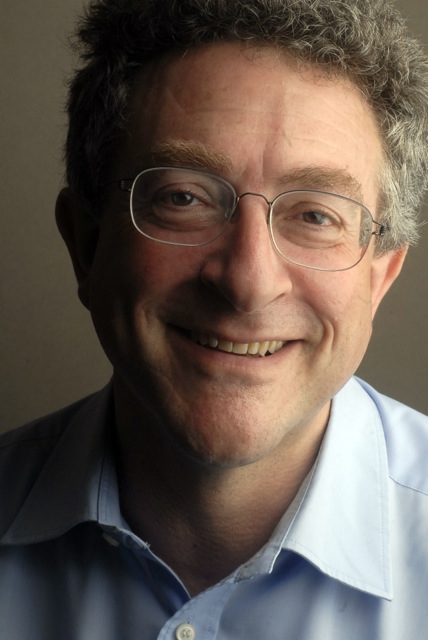
The four concerts covered in this extended review can give but little indication of how much new music was heard in six days, how much music by a single composer was performed (Dutilleux’s centenary was celebrated, for example), or the variety of work on offer from living composers. But they can indicate the numerical range of forces for which all of it was written, from solo recitals to choral and orchestral works, some of it conducted by indefatigable festival director George Vass, who on the penultimate day between concerts could be found grabbing a bite to eat at one the town’s crowded but amenable cafés, probably not for the first time. The unstuffy Presteigne Festival never stands on ceremony. That’s besides the coverage of visual art, poetry and film (Michael Caine’s movies were featured) and the walks, interviews and lectures.
On paper it looked breathless, but it turned out to be leisurely and free of impediment. Kenneth Loveland, my predecessor as music critic on the South Wales Argus, said it was impossible to attend a Presteigne concert and not witness at least three composers popping up to receive plaudits. He wasn’t exaggerating much. These days, with the flow of royalties slowed or dried up, much new contemporary music is lucky to have a second or third hearing. More’s the pity, and hence the sight of composers following their music around the festival’s several venues to hear it set against the classics, and works by their coevals. In few places could they fault its advocacy.
Still, it requires music of eloquence and substance to match an opus such as J.S. Bach’s Suite No. 2 in D minor (BWV 1008) for solo cello, which ended Alice Neary’s recital at Discoed. Dutilleux’s Trois Strophes sur le Nom de Sacher begins with and generally insists upon devices intended to subvert expectations of the cello’s familiar soundscape, including a scordatura on two strings, some self-conscious sonic effects, and the theme employed in reverse. All well and good as far as it goes. But its opening is marked indeciso and the three stanzas promise a resolution that some might find unconvincing – or still ambiguous. Neary announced with endearing personification that her cello ‘hated’ being tuned down. Suitably restored, it seemed happy in expressing the picto-narrative suggested by the Hawkins work, Stranger, Lover, Dancer, which at one point exhibits an elegiac strain before moving towards a more obviously unequivocal outcome.
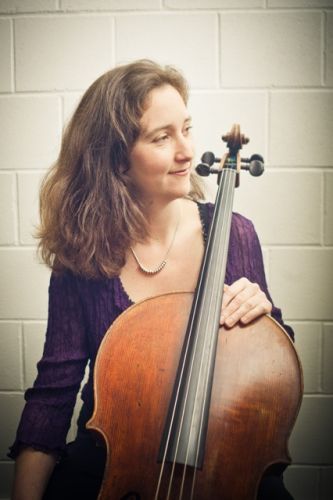
Saxton’s Sonata for Cello on a Theme of Sir William Walton, like much of his other work at the festival, is densely patterned and rigorously argued. It states the theme at the end, though the foregoing exegesis finally begins to display Waltonesque features, perhaps its most interesting quality. The theme itself turns out to be unmemorable for being understated and its ‘stalking’ through contrasted but linked movements promised no contest for the Bach work. Neary, however, seemed to have given her all in the foregoing music, leaving the final laps of the Bach to be completed with more stoicism than flair. It could have been her most exacting sixty minutes of recent months. Even so, the account was still of a high standard.
Vass was in charge of the festival’s chamber choir and orchestra at Presteigne’s St. Andrew’s Church for one of those salon versions of the Fauré Requiem. A church, of course, is no sitting-room, a paradox dealt with by the conductor with an emphasis on those few sections where the composer raises his voice. In that context, baritone Damian Thantrey’s contributions were pitched just so, as were choir soprano Sophie Edwards’s in the Pie Jesu. Before Fauré there was James Francis Brown’s The Heavens and The Heart – Three Psalms for Chorus and Small Orchestra. It requires a bigger band than the one settled for in the Requiem. The choral writing is Old Testament fibrous, with points to make on route and an ending resolutely jubilant. Here was a case for more voices, not fewer, though that might have upset the balance.
Deborah Pritchard’s resourcefulness in making a little go a long way in Wall of Water, her 2014 concerto for violin and strings inspired by the aqua-themed paintings of Maggi Hambling, nevertheless results in a descriptive work with a firm musical structure lodged in tonality; it justifies the duration, even without sight of the pictures it is responding to. Nowhere does Pritchard let the music liquefy, as it were. The bookend cadenzas, with two different pedal points, and the pitting of soloist against orchestra help provide a fitting addition to British music’s marine repertory. Alexandra Wood discharged her solo obligations with passion and finesse. At a festival in which music by living composers was, for one reason or another, sometimes brief, it was good to see brevity enriched by intense feeling in Adrian Williams’s Elegy, occasioned by the deaths of two friends: the film director Ken Russell, and the composer’s teacher at the Royal College of Music, John Russell. The grief is almost too powerful to bear in places and Williams brings in solo strings to help shoulder it. Vass sought and located the essence of each of these works, insisting as much on Williams’s quietude as on Brown’s oratory and Pritchard’s bravura.
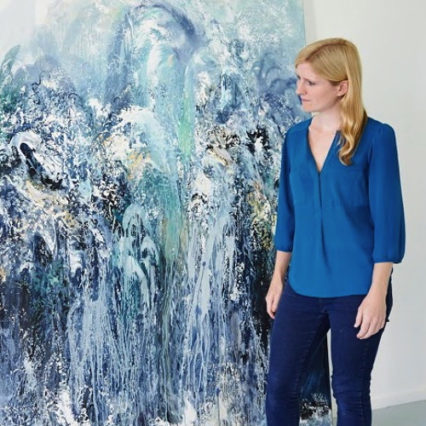
The ‘Britten at Bleddfa’ concert on bank holiday Monday at the well-appointed St. Mary Magdalene Church was so described because it included Britten’s stupendous String Quartet No. 2 in C and Michael Berkeley’s Clarinet Quintet, Berkeley being Britten’s godson. On hand were the Carducci Quartet and the clarinettist Rozenn Le Trionnaire. But it was Saxton’s Fantazia for string quartet of 1994 that opened proceedings with such high endeavour. It nods towards the 17th century and the music of Purcell, who is credited with substituting ‘z’ for ‘s’ in the title of the age’s favoured form of viol playing. Saxton brings the counterpoint and earlier polyphony up to date in three movements of riveting contradistinction and intensity. It could so easily have been a shotgun marriage of old and new if he had not conducted the ceremony with such aplomb and with so much confidence in its propriety and in its prospect of something newly minted rather than plainly re-fashioned.
The Carducci served him well. It easily settled into its concertante role for the Berkeley quintet that followed, with Le Trionnaire the perfect conveyor of its wistfulness and capacity for revival. It’s a fine, light work, never tempted to call upon the concentrated energy of which such a combination of instruments is capable. Berkeley was present to acknowledge its re-awakening. There’s a Purcell connection too with the Britten quartet, which was premiered in 1945 precisely 250 years after the earlier composer’s death; and a Saxton link in the quartet’s exhilarating union of ancient and modern. This is Britten the chamber-music writer at his most spacious, inventive, and epic. The work is an awe-inspiring panorama, its Purcell relationship explicit at the end in a chaconne of spirited variations, for which Purcell had used the English derivative term ‘chacony’. The Carducci emphasised all the work’s best features with galvanised and expansive playing.
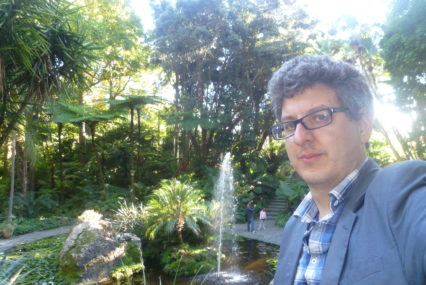
Saxton’s Chacony for Piano, Left Hand made for more continuity back at St. Andrew’s, when soloist Emily Pailthorpe took a short rest from her duo recital with Clare Hammond, allowing the pianist to give it a robust and considered treatment. It grows into a virtuosic piece beginning with a modified whole-tone scale followed by the development of a ground that soon requires the pianist to work up a volume by hammering the keyboard, before the initial atmosphere is restored. Hammond caught both its compensatory wholeness and its interesting sense of frustration in six minutes of coolness under pressure. Perhaps because of the church’s changing ambience on a sunny day, or for some other reason – there were a couple of near-blips – Pailthorpe changed her reed and twice dragged the swab through her instrument after beginning the recital with Poulenc’s Oboe Sonata, though she and Hammond had essayed the composer’s characteristic bitter-sweetness and wit. Saxton made a second appearance with Arias, a five-section work, songlike as its title indicates, with the oboe and piano alternately drawing sweetly on the original material played by both together and in the end quietly falling away. It was another exquisite Saxton brevity, as much about the singers as the songs.
Pailthorpe switched to the cor anglais for Thomas Hyde’s Winter Music – unusual because it’s based on a song setting of words by the poet Kathleen Raine about angels, a breed of creatures not usually associated with the reedy low manoeuvres of the English horn, even with the piano in dulcet support. Each to her own pictures, then, which could also have been said about Ninfea Cruttwell-Reade’s RPS/Presteigne Festival/Alan Horne Memorial commission, Ravens’ Cage. It’s a piece of dark and hesitant minimalism, the onomatopoeic oboe piping the noises coming from a place in the Victorian London Zoo, where onlookers, with a mixture of awe and voyeurism, were invited to gawk at fearsome feathered predators. It wouldn’t happen today, and the music is a commentary on what we (but not the Victorians) would feel about it. This is ghostly music describing a place rendered desolate by enlightenment, but with remnants capable of re-forming; wherein lies its eeriness. The recital ended with the sometimes shrill and aggressive Oboe Sonata of Dutilleux, the first two movements of which were written for the revived Paris Conservatory concours of 1947. In a recital where one instrument frequently gave way to the other, the cooperation here was binding, especially in the central scherzo.
The Fauré Requiem‘s association with remembrance was part of the festival’s Somme theme, in which the effect of war on composers was examined in work by Stravinsky (L’Histoire du Soldat, performed by Nova Music Opera), Messiaen, Shostakovich, Adrian Williams, Saxton, and Richard Rodney Bennett. The world première of Saxton’s The Resurrection of the Soldiers, for strings, was given at the final concert in St. Andrew’s by the orchestra under Vass. It was a joint Festival and English Symphony Orchestra commission inspired by a Stanley Spencer painting that depicts soldiers emerging from their graves towards a better dawn. In its wider peacetime ramifications, resurrection of music from our own time and to a lesser extent from the much-plundered distant past continues to be the festival’s main reason for being. Long may it be so.
Header image: Presteigne Festival artistic director and conductor, George Vass


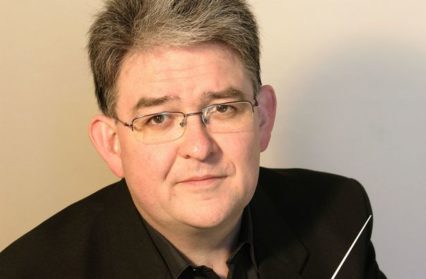
 Enjoyed this article? Support our writers directly by buying them a coffee and clicking this link.
Enjoyed this article? Support our writers directly by buying them a coffee and clicking this link.







